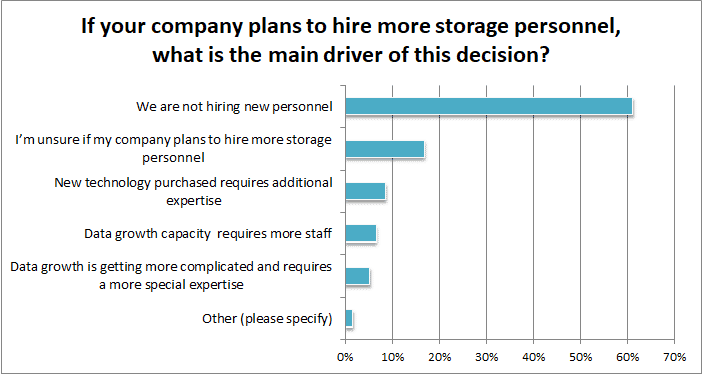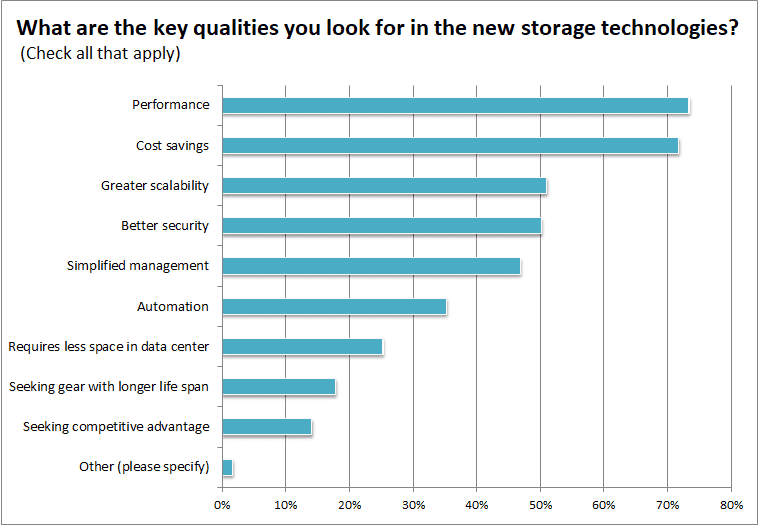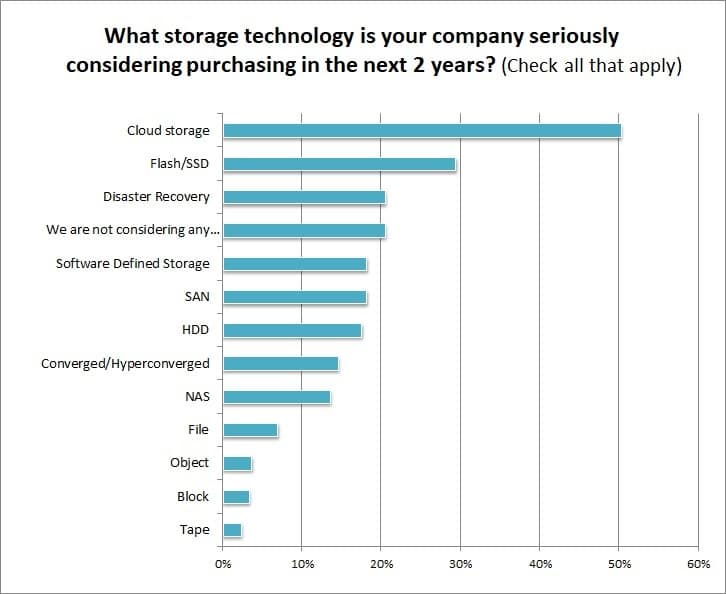Enterprise Storage Forum’s recent survey on data storage revealed that while many companies are investing in new technologies, the majority are not adding IT staff. Entitled Data Storage Trends 2018, the survey asked about hiring trends. In response, 61% answered, “We are not hiring new personnel.” An additional 17% responded, “I’m unsure if my company plans to hire more storage personnel.”
Add those those two responses together and it’s clear: data storage environments are facing an essentially flat head count – in the face of ever increasing storage work loads. Let’s take look:
See the highlights from our survey of the data storage world in this .
Low Hiring Creates Storage Challenges
The flat IT headcount that the survey reveals appears to be the case for several reasons. Some companies added large numbers of staff and now find themselves overstaffed – not to mention having to report ballooning operations expenditures on annual financial reports. These companies may lay-off extra personnel, but others choose not to.
Some companies reassign IT personnel to strategic projects, train staff in upper level skills, and only hire to replace key expertise. Others have spent time and money on implementing highly efficient IT procedures, so they do not need to hire more staff.
Whatever the reason for the flat headcount, new storage technologies and sheer data growth are forging ahead. IT departments that are too lean and staffers who lack higher level skills will struggle to keep up.
Despite flat employee headcount, IT has some big challenges to meet. The survey also asked the question: “What is the biggest challenge involved with operating your current storage infrastructure?”
Again, while these responses speak to many issues, at one level they relate to staffing. Respondents identified these leading challenges (which are 3 of the top 5 challenges):
· High costs of operation: 14%. Even with a small team, IT staff’s salaries and benefits are usually the highest operational costs in IT. This puts pressure on all IT departments to save costs in other areas or face even more changes to headcount. Cloud migration represents another large operational expense for IT, especially in companies without an IT chargeback process. The more that a flat IT department lowers other operational costs, the less likely senior management is to decrease headcount as a cost-savings measure.
· Security and compliance: 13%. A storage department with a lean headcount bears no less responsibility for securing retained data. Data storage admins are – no matter how understaffed – are always responsible for data protection and data retention management. Security and compliance domains include protecting stored data against theft or loss: not only on-premises but in the cloud. Storage IT is also responsible for the data portion of DR/BCP (disaster recovery/business continuity planning), incident response regarding lost or exposed data, and compliant retention schedules and retirement.
· High maintenance requirements: 10%. IT staff time spent on storage maintenance officially falls under operational costs. High maintenance requirements also cost storage admin time, which subtracts from their ability to use upper level skills and to run strategic IT projects. Smaller staff cannot simply offload tasks to new hires: they need to conduct maintenance and work on high value ROI activities.
How Storage Job Growth Influences New Technology Purchases: Stretching Resources
Take a look at the key qualities that companies look for in new storage technologies (see below). The survey’s major findings for making storage work with lean IT are taking advantage of new automation technologies, simplified storage management, and leveraging cloud data storage.
How can companies with lean IT departments efficiently run their storage infrastructure and invest in new technologies? Let’s look at best practices for assuring that IT can meet the challenges of a dynamic and evolving storage environment, even if they are not hiring new personnel.
At first glance, lowering staffing costs while improving performance, scalability, and security seems unlikely. But it is entirely possible even for lean IT teams by combining effective new technologies with management simplification and strategic use of the cloud.
· Greater Scalability, 51% – Scale-out systems solve capacity headaches around traditional storage systems. Scaling keeps costs low by using commodity hardware and enables linear performance and capacity scaling. The architecture is highly redundant for high availability. Since redundancy is native to the architecture, it saves money on expensive availability measures.
· Performance, 72% – Falling flash/SSD prices make high performance arrays more affordable for companies. And for those companies who need even more performance, NVMe technology accelerates the SSD data path without having to replace flash arrays for higher speed SSDs.
· Automation, 35% – Simplifying storage management was important to our respondents. This is especially true with IT groups who cannot easily add new personnel. Granted that many IT departments simplify storage management by turning storage and its management over to a cloud provider. However, few companies turn over all applications and data to the cloud, so IT must effectively manage on-premises storage.
Automation also allows the following ‘staff stretching’:
Storage management software saves storage admins time by automating storage management functions. A storage vendor may provide management software on their device or family of devices, or the management software may be a 3rd party offering.
Automating routine IT activities enables storage admins to increase service levels without adding staff. For example, admins can protect performance on primary systems by automating storage tiering. Typical paths include tiering from primary storage to active archives and then the cloud, or from primary storage directly to cool or cold cloud tiers. Additional rich automation is dynamic upgrades and policy-driven storage management.
Automating backup lets storage admins easily manage backup and observe compliant retention schedules. Even a lean team can effectively manage large volumes of backup data with automation and searchability.
Cloud Storage and the Shrinking Workforce
The survey indicated that most respondents plan to use cloud storage in greater numbers.To be sure, this is not entirely due to staffing concerns, but staff costs do play a role here.
Yet simply migrating to the cloud does not guarantee efficient usage of the cloud – or the cost savings of lean headcount IT. Optimizing cloud environments is important to performance, but IT departments often trust the provider’s default settings. Cloud storage can get very expensive as the amount of data grows, and the cost of egress adds up fast.
One key point about cloud and IT staffing: Cloud expertise. Hire or train IT personnel who know how to work with cloud providers to optimize individual cloud storage settings, including data protection and security.
According to our respondents, end-of-life is a driving force behind new hardware, software and services investments. Take advantage of the changes you know are coming to plan for current and future storage needs. By taking the time to make strategic plans, IT saves time and money and improves service quality – even in the age of low headcount lean IT.








